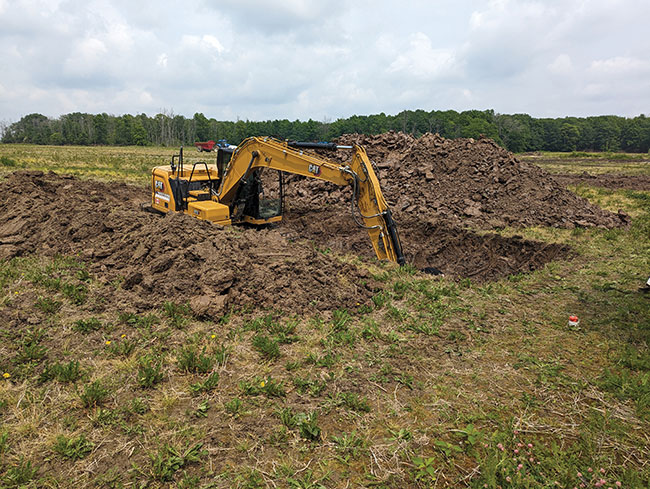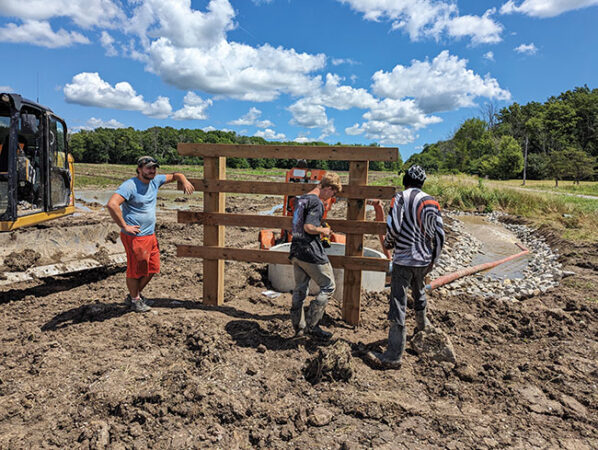
Features
Contractor at Work
Building the business, building the market
Ontario contractor Ken Watkins on establishing drainage in an underserved area.
December 15, 2023 By Bree Rody
 Haldimand County, where Watkins is based, is known for heavy clay soils.
Image courtesy of Ken Watkins
Haldimand County, where Watkins is based, is known for heavy clay soils.
Image courtesy of Ken Watkins Ken Watkins’ pride in his work is similar to that of a sculptor or architect. On every drainage project the Ontario-based contractor embarks, Watkins loves to document the process, share images and videos and take in the good work he’s done.
Besides the standard feeling of pride and accomplishment from a job well done, he’s also proud that not long ago, much of the region in which he works was swamp-covered.
A humble beginning
Watkins Drainage boasts a small team, and thus Watkins still spends considerable time in the machines himself. The process gives Watkins a thrill. But it wasn’t long ago Watkins made his living as a hog farmer.
Although, he admits that “made his living” is not indicative of how the experience really was.
“Pig farming in Ontario is very financially and personally demanding,” says Watkins. “It doesn’t reward your efforts very well.”
Watkins had grown the family farm significantly, and was struggling – he says at times, he felt destitute. As many thrifty farmers tend to do, Watkins began draining his own land, running laser on a small tile plow. Having amassed some gear, including a Trimble auto-steer, Watkins was becoming increasingly curious about the potential of the machines to do more. “I’d always be asking the dealer, ‘what else can this Trimble gear do?’ I was trying to find more applications of this GPS gear to broaden my spectrum.”
Around 2012, his equipment dealer eventually pointed him to a drainage seminar at a local co-op, which allowed Watkins to view a drainage plow up close. His response to the opportunity? An emphatic “hell yeah!”
After attending the seminar, Watkins went home and bought the system that night to install on his plow. “I took it out, ran it for three hours and literally called the trucker that night and told him to liquidate the herd.”
A unique market
Watkins had spent his entire life in the area of Cayuga, part of Haldimand County. Nestled in southern Ontario about a 15-minute drive inland from Lake Erie and an hour from the border into the U.S., Haldimand and its neighboring county of Norfolk are known almost exclusively as agricultural communities.
And yet, Watkins observed, one area in which Haldimand was lacking was drainage. “I recognized that drainage needed to be done, and no one in my area was doing it.”
And that doesn’t mean there were no local contractors – he means there was no draining of the land at all. Admittedly out of character for southern Ontario, where drainage is an already established practice, Watkins found from drainage maps at the time that Haldimand seriously under-indexed. “Ontario is 90 percent tile-drained,” he explains. “But Haldimand County was five percent drained at the time.”
He says Haldimand was often regarded as “the last bastion of cheap land in Ontario,” so for farmers, the outlook had often been “why waste time draining land when I could just buy more land?”
But land is finite, and Watkins knew that once landowners saw the benefits of drainage, they wouldn’t go back. He secured the necessary licenses, took the necessary courses, made his investments and tiled his way around the county. He had a unique challenge at the time, he says, noting “I had to build the market at the same time as I was building the business.”
Now, after 10 years, Watkins has seen the market grow, but never forgets where the area came from.
“What I enjoy most about this work is driving around the back roads, looking at farms that used to be swamp-covered, and now they’re not,” he says. “There used to be just oceans of water covering them.”
Although Haldimand and Norfolk are often grouped together – its citizens often hop from one county to the other for work and recreation – and Watkins indeed serves both as a contractor (as well as the nearby Brant County and Niagara Region), it poses unique geographic challenges.
Haldimand, once a densely forested area that invited a thriving forestry industry in the 1800s, has a very different soil profile from its neighbor to the west.
“Haldimand is reputed for what they call Haldimand Clay,” explains Watkins. “It’s particularly nasty, heavy clay, and doesn’t drain well.” He adds that a contractor used to working with sand won’t have any luck using the same approaches for clay. In fact, there is a large segment of the local farm community that believes tile doesn’t work around there, because of work performed by contractors visiting from sandier soils.
That clay means Watkins regularly does a mix of surface and subsurface drainage. “We use tons of gravel and tons of surface [drainage]. Putting pipe in the ground is only five percent of the project… getting the water into the pipe is the other part.”
For their gear, Watkins Drainage is currently on its fourth tile plow, a Bron self-propelled plow. “That Bron plow has been a big boost to my business. The ability to put pipe in the ground is unbelievable.” The four-man team currently runs three complete GPS systems in the plow, the survey vehicle and excavator. They also use locating equipment, and laser-based trenching equipment.
Beyond that, Watkins says he relies on his local CAT dealer. “We’re pretty much CAT across the board. They’ve got in-office systems, maintenance systems, access to all sorts of customer support.”

Ken Watkins is a firm believer in empowering his young employees to see their potential in business.
An eye on the future
There are currently a lot of demands on drainage contractors. Gone are the days of old when contractors didn’t have to be concerned about the environmental implications of the work they do; they’re expected to have working knowledge of soil and water science, all while handling their machinery and equipment expertly.
But for Watkins, being keenly aware of economics is another must-have skill for contractors. Knowing what’s got farmers concerned – which often boils down to money – dictates what Watkins’ projects are going to look like.
“What landowners are concerned about right now is interest rates,” he says. “Everybody’s coming to grips with this new reality. So recently, the scale of projects has gotten smaller. Guys are doing smaller jobs.”
Because the very nature of farming often means a landowner holds multiple mortgages at once, the bigger farmers are in what Watkins says is a “constant state of renewing mortgages.”
“I’ve had guys who tell me, ‘last year, my mortgage was $50,000, now it’s $100,000.’”
That doesn’t mean drainage work has – no pun intended – dried up, but it does mean systems are not as grand or complex as they may have been even a few years ago, when interest rates were blessedly low.
In fact, Watkins says landowners are more cognizant of the need to drain the land, especially with wetter wet seasons. While belief in climate change used to be divided along political lines, Watkins says he now sees the sentiment from people of all walks of lines. “People are looking at the weather and going, ‘things are not like they used to be.’ Call it what you want, everybody’s saddled with it.”
But despite unpredictability from year-to-year, Watkins says his clients are seeing predictable results, which is what matters.
“You can see it with your eyes,” he says. “The question is always, ‘what happens on the dry years?’ After 10 years, they’re seeing… On the dry years, the tiled ground out-produces the untiled ground. On the wet years, the same thing: tiled ground out-produces untiled ground.”
That’s not to say everyone is “jumping on the bandwagon,” says Watkins, but little by little, as the market builds and years of data and anecdotes prove the effectiveness of drainage, Watkins says there’s still potential for even more work to be done.
But when asked what he hopes to achieve in the future, Watkins is less focused on the technical aspects of drainage and more on the business aspects. Namely, having a succession plan in place is a major area of focus. He also is dedicated to making sure the young workers on his team understand that they, too, have the potential to establish their own businesses in agriculture.
“I don’t have children myself, but I hire all young guys. I put them through the ‘Ken Watkins heavy equipment operator school.’ I run young guys for one to two years, team ‘em how to run the equipment, and then they go off to the city, get the big money jobs.”
He says given the cost of living and the cost of housing, he wants young equipment operators to dream big and consider their potential to be more than just an equipment operator and thrive as a business owner. “I went from farming to tiling – abject poverty, almost, to being more comfortable… I constantly tell these guys, ‘you think you can’t run your own business, but you can. I’ll show you how.’ The machines will pay for themselves. The tile will pay for itself. I’m trying to encourage some of them to join with me and get into the business.” DC
Print this page